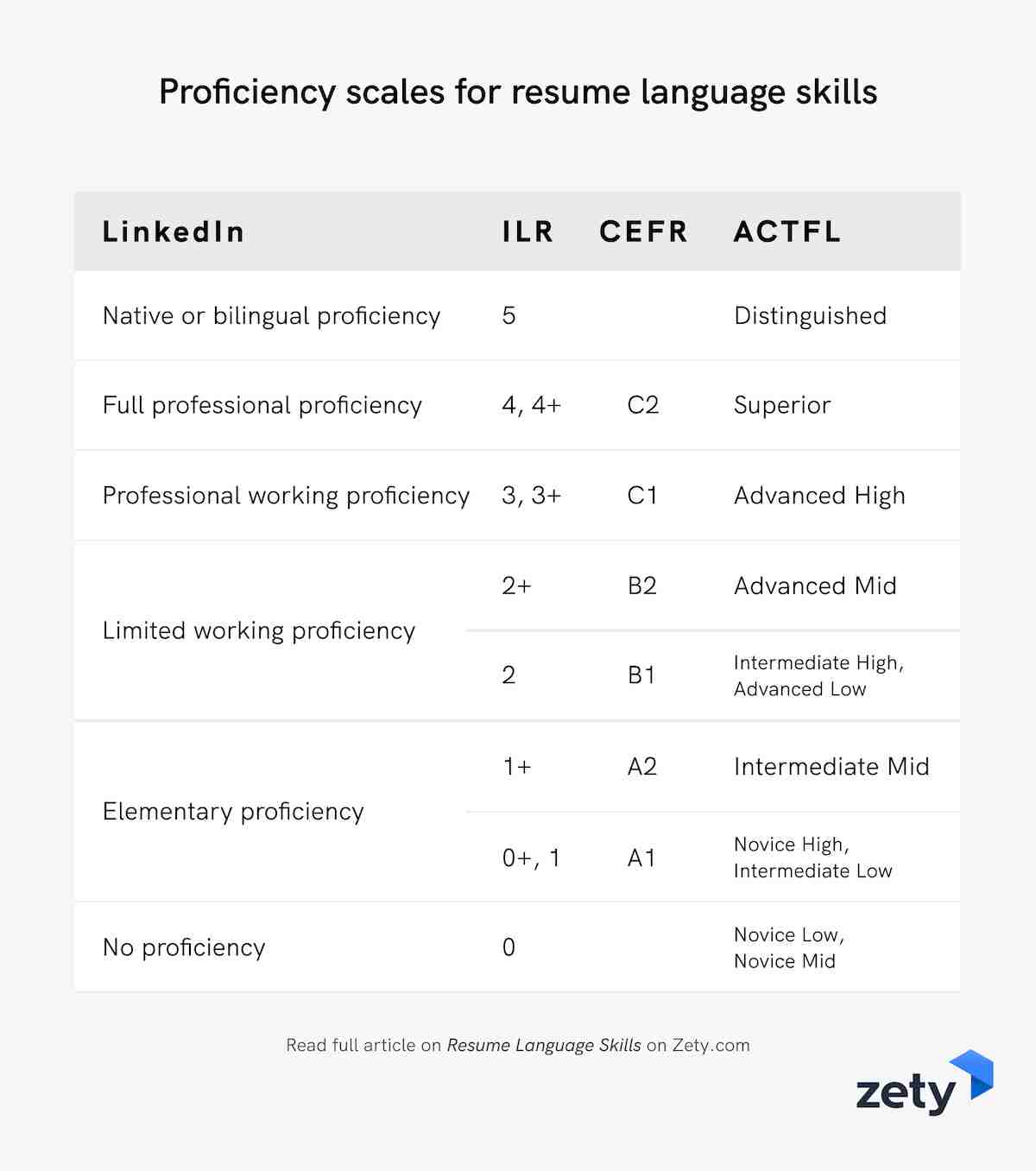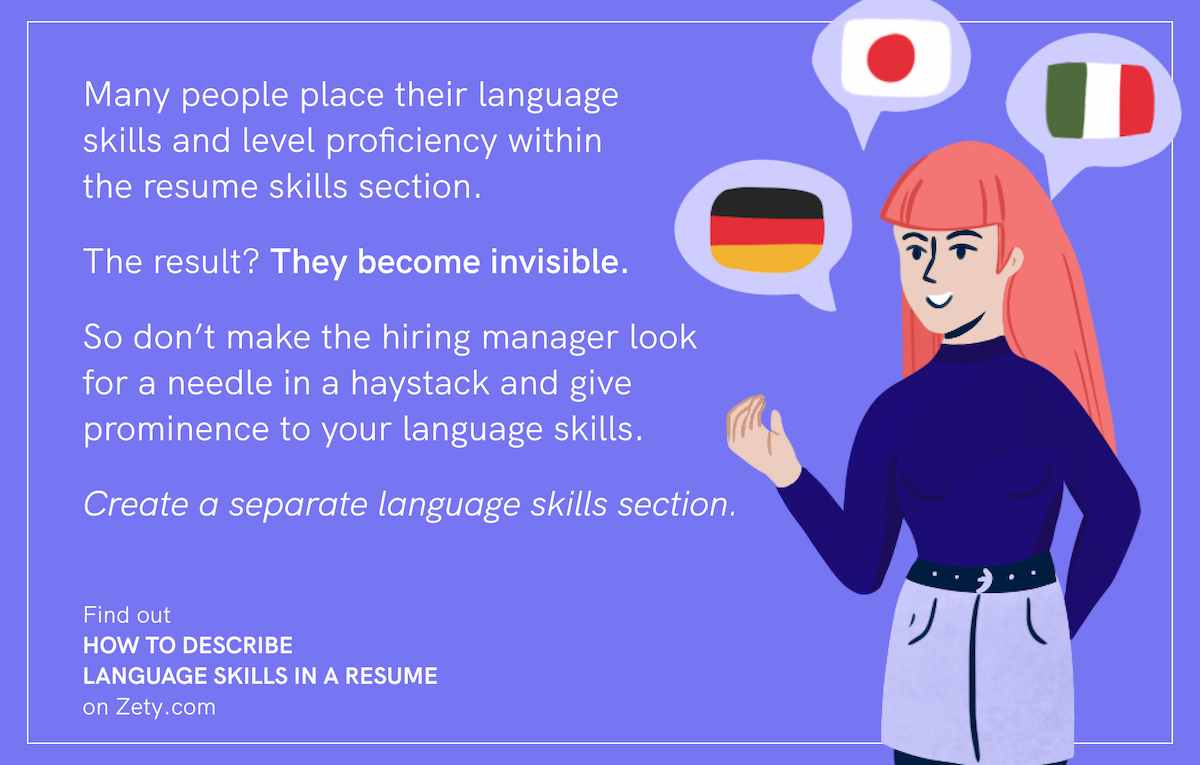How to Show Levels of Language Proficiency on a Resume
Create Your Resume NowDo you want your resume to open doors and land you that job? Then add your levels of language proficiency to a resume. Read on and learn how to boost your job application with resume language skills, with detailed explanations on where to put language fluency levels on a resume.
This guide will show you:
- How to include language skills levels in resumes to prove more valuable than the other candidates.
- How to describe levels of language proficiency on a resume and determine your fluency level.
- Inspiring resume language skills examples for different situations.
Want to save time and have your resume ready in 5 minutes? Try our resume builder. It’s fast and easy to use. Plus, you’ll get ready-made content to add with one click. See 20+ resume templates and create your resume here.
Sample Resume made with our builder —See more resume examples here.
If you want to know how to list programming languages on a resume, check out:
What Are Language Skills?
Language skills enable you to speak, read, and write in different languages. They are important, as they allow you to communicate with a diverse range of people, whether it's coworkers or clients. There are different proficiency levels you should mention in a language skills resume section.
Being able to speak more than one language is attractive for hiring managers, as it shows you're able to learn something new; you're a dedicated and hard-working person. You also have cultural knowledge that can prove valuable. Plus, it’s a great way to make your resume stand out even more. So let’s see exactly how to do it right.
Pro tip: Being bilingual isn't just a resume skill or a resume strength, it's a resume superpower. Creating a bilingual resume — especially since the demand for bilingual employees has doubled in recent years — is a great idea. Besides the language skills section, mention you’re bilingual in your resume summary or resume introduction.
How to Describe Levels of Language Proficiency on a Resume
A language proficiency scale is a framework created to grade language levels based on language accuracy, fluency, and other factors. It standardizes scoring so everyone is on the same page, and there’s less confusion.
Here are the most common language proficiency level frameworks:
- Interagency Language Roundtable (ILR): it has 6 language skill levels (0-5), and an additional “+” designation for those pesky in-betweens.
- Common European Framework of Reference for Languages (CEFR): it’s a widely recognized scale that goes from A1 (Elementary) to C2 (Proficient) levels.
- American Council on the Teaching of Foreign Languages (ACTFL): in this scale, the language fluency levels include Novice (Low, Mid, High), Intermediate (Low, Mid, High), Advanced (Low, Mid, High), Superior, and Distinguished.
And here’s how the main language scales’ scores compare to one another:
Language Levels for Resumes
ILR | CEFR | ACTFL | |
Native or bilingual proficiency | 5 | Distinguished | |
Full professional proficiency | 4, 4+ | C2 | Superior |
Professional working proficiency | 3, 3+ | C1 | Advanced High |
Limited working proficiency | 2+ | B2 | Advanced Mid |
2 | B1 | Intermediate High, Advanced Low | |
Elementary proficiency | 1+ | A2 | Intermediate Mid |
0+, 1 | A1 | Novice High, Intermediate Low | |
No proficiency | 0 | — | Novice Low, Novice Mid |

Remember always to mention the language levels in a CV or resume. A list of languages with no further explanation is not useful to recruiters. Just use the above-mentioned scales as language levels for resumes.
Okay, but how can you do it right?
How to Find Your Language Level of Fluency
Don’t speculate your language level in a resume. Either you’ll overestimate your abilities, or you’ll underestimate them.
Instead, choose one of two options:
- Official language certification: it’s best when the job requires the language in many ways. Most language schools offer exams and certificates, and you can also obtain language certification online.
- Self-assessment: follow the official guidelines for each framework to find out what’s your level. You can find details about the ILR scale, CEFR grading, and ACTFL scale on their websites.
Pro Tip: If your language abilities are as good as a native speaker’s, say you possess near-native skills. You won’t be lying on your resume, and your application might just pass the automated scan (if being a native speaker is critical for the position.)
Making a resume with our builder is incredibly simple. Follow our step-by-step guide, use ready-made content tailored to your job and have a resume ready in minutes.
When you’re done, Zety’s resume builder will score your resume and our resume checker will tell you exactly how to make it better.
How to List Language Skills on a Resume
Don’t list your resume language skills and levels of language proficiency in the resume skills section together with job-related hard skills and soft skills. Give prominence to your language skills instead. A resume with a singled-out language section is superior and can move you to the top of the list of prospective candidates.

A language resume skill section makes for a great resume category section. If you have any certificates (more on that later), make sure you include them in the certifications and licenses section.
Here’s how to write language skills in a resume:
Give Your Language Skills Their Own Section
Create a separate language skills section to distinguish your language abilities from your other skills. This will definitely catch the reader's attention more effectively.
Add the Language Skills After the Core Sections
Since it’s not the most important part of your resume, add the language skills section after your resume’s heading, experience, skills, and education sections.
Choose One Language Rating System
Whether you state your language proficiency level in brackets or as a bar, choose one rating system and stick to it.
Start With the Language You Are Most Proficient In
Listing the languages you are most proficient in first will draw more attention from your readers.
Add Regional Variants of Languages if You Specialize in Them
Many languages have different regional variants. Highlighting certain variants can be a winning point for you.
Skip Languages That You’re a Novice With
If you’ve only just started learning a new language, don’t mention it on your resume, as your future employer won’t find it useful.
Resume Language Skills: Examples
Check out examples of how to put language skills on a resume:
Skills: Languages in Resumes Sample
- American English—Native
- Brazilian Portuguese—Fluent
- Egyptian Arabic—Conversational
- Bravanese Swahili—Limited working proficiency
Simple and very easy to understand for recruiters.
You can also use the widely-recognized frameworks to indicate your language skills. Check the samples below:
Sample Resume: Languages
- English—Level 5 (ILR)
- Bengali—Level 4 (ILR)
- Mandarin—Level 3 (ILR)
Adding the name of the scale next to the level helps recruiters understand which framework you’re talking about.
Here’s one more language resume skills section sample:
Levels of Proficiency in Resumes: Sample
- American English—Native/Bilingual (ILR Level 5)
- Canadian French—Native/Bilingual (ILR Level 5)
- Russian—Full Professional Proficiency (ILR Level 4+)
- Malay—Professional Working Proficiency (ILR Level 3)
This sample shows a combination of LinkedIn language proficiency levels with the ILR scale. It’s a great way to go if the recruiter posted their job ad on this particular network. Of course, remember to also optimize your LinkedIn profile before applying!
Here’s one further example to show a different point:
Language Levels on a CV: Example
- British English—Native/Bilingual
- Italian—C1 Certificate
- Polish—B2 Level
That’s for a resume in Europe using the CEFR scale. Notice the difference in the Italian and Polish languages? It means we earned an official certificate of Italian C2 level, but we self-assessed our Polish as a B2.
There’s no single right way to add your levels of language fluency. However, there are some mistakes you can make, so be careful.
- Be consistent: don’t mix and match language proficiency frameworks.
- Use the most relevant system: if you apply for a job in the EU, use the CEFR levels.
Pro Tip: Some people have put their years of language use when describing proficiency, but this is a big no-no. Your 3 years studying Spanish in high school is usually less effective than living in Costa Rica for 3 months.
Plus, a great cover letter that matches your resume will give you an advantage over other candidates. You can write it in our cover letter builder here. Here's what it may look like:
See more cover letter templates and start writing.
Key Takeaway
When adding language fluency levels to a resume skills section, keep in mind:
- Add your levels of proficiency in languages to its own section.
- Use a language framework instead of using your own wording for fluency.
- Choose the most appropriate language scoring system for your job.
- Remain consistent and relevant throughout your resume language section.
- Self-assess your skills rather than estimating your competence.
Have any questions on how to write about language skills in resumes? Not sure which language proficiency framework or scale to use? Let’s talk about this using the English language in the comments below, and, as always, thanks for reading!
About Zety’s Editorial Process
This article has been reviewed by our editorial team to make sure it follows Zety's editorial guidelines. We’re committed to sharing our expertise and giving you trustworthy career advice tailored to your needs. High-quality content is what brings over 40 million readers to our site every year. But we don't stop there. Our team conducts original research to understand the job market better, and we pride ourselves on being quoted by top universities and prime media outlets from around the world.
Sources
- http://www.govtilr.org/index.htm
- https://www.govtilr.org/Skills/ILRscale2.htm
- https://www.coe.int/en/web/common-european-framework-reference-languages/table-1-cefr-3.3-common-reference-levels-global-scale
- https://www.actfl.org/
- http://www.newamericaneconomy.org/wp-content/uploads/2017/03/NAE_Bilingual_V9.pdf
- https://www.actfl.org/educator-resources/actfl-proficiency-guidelines



